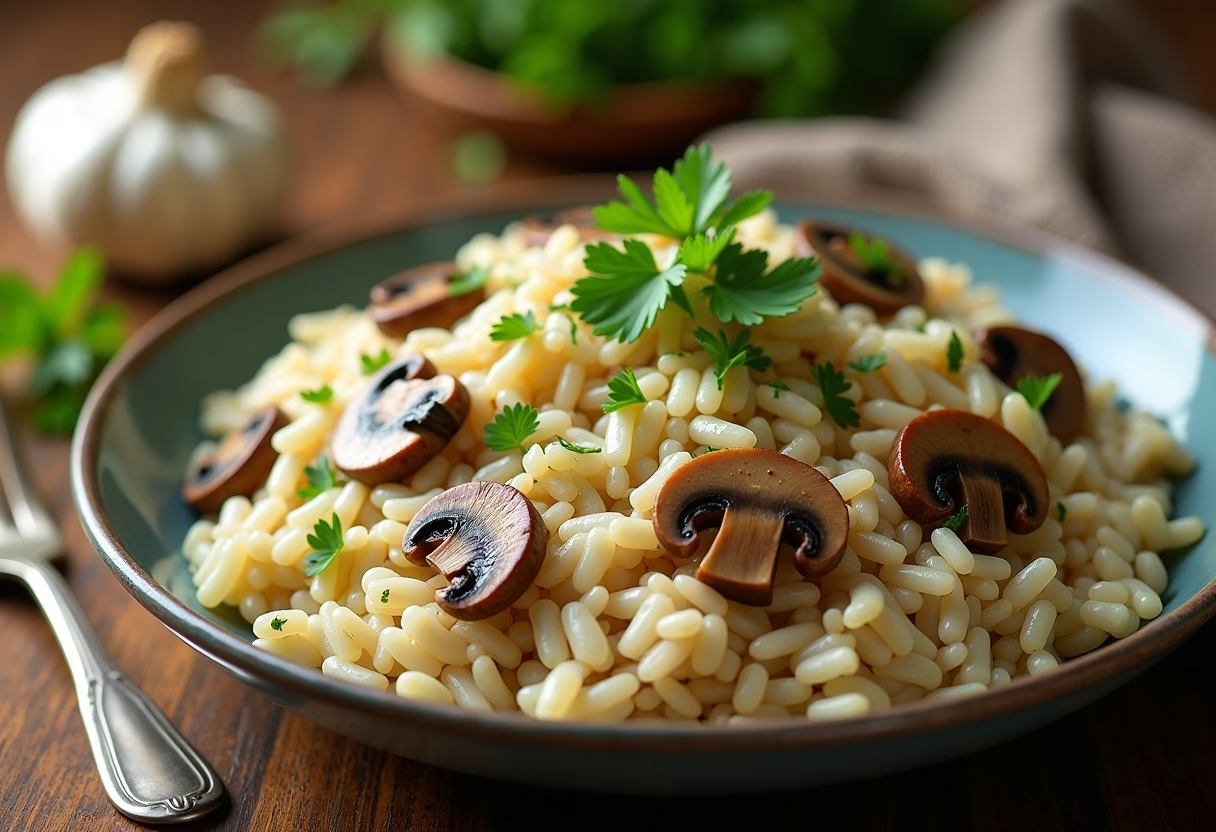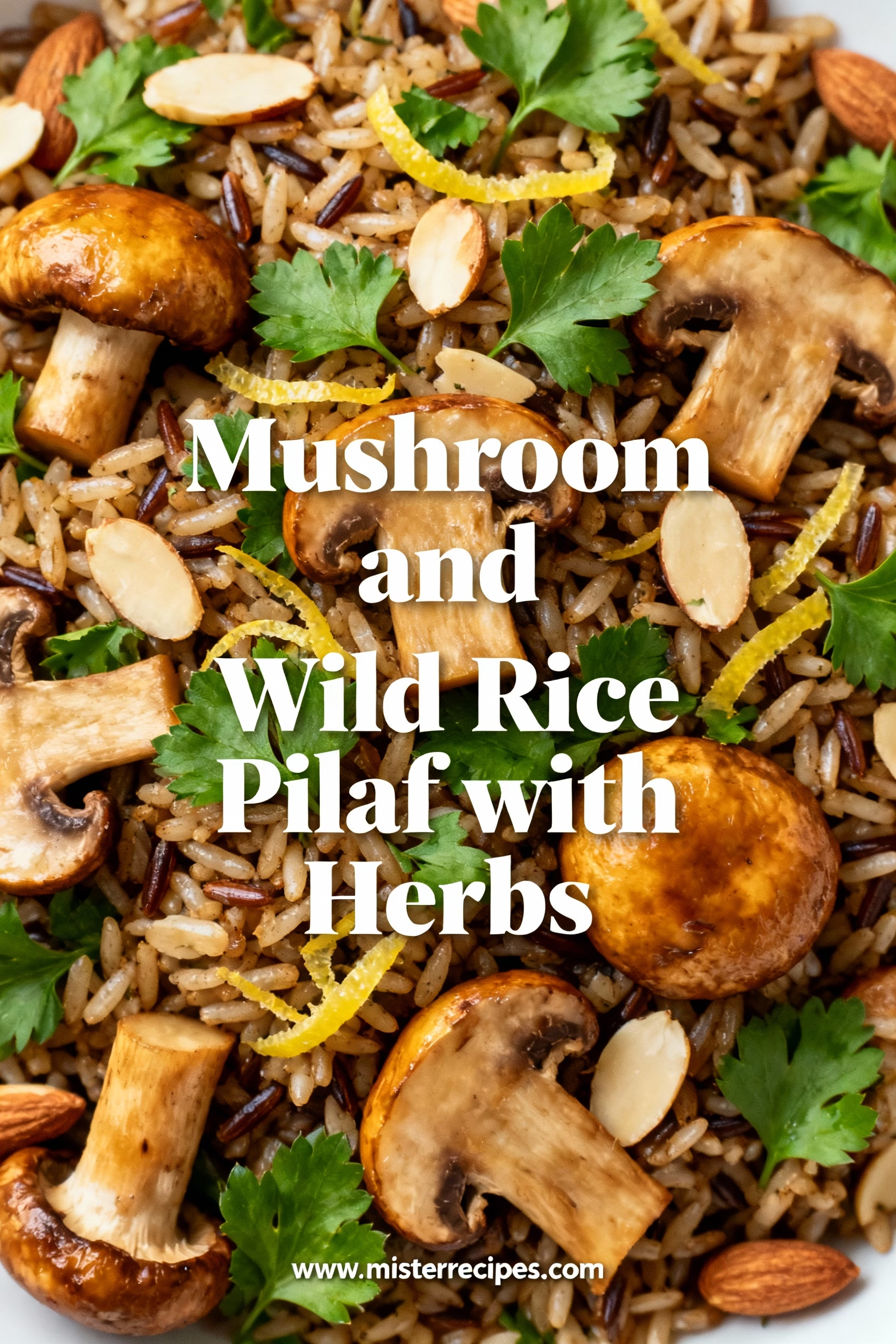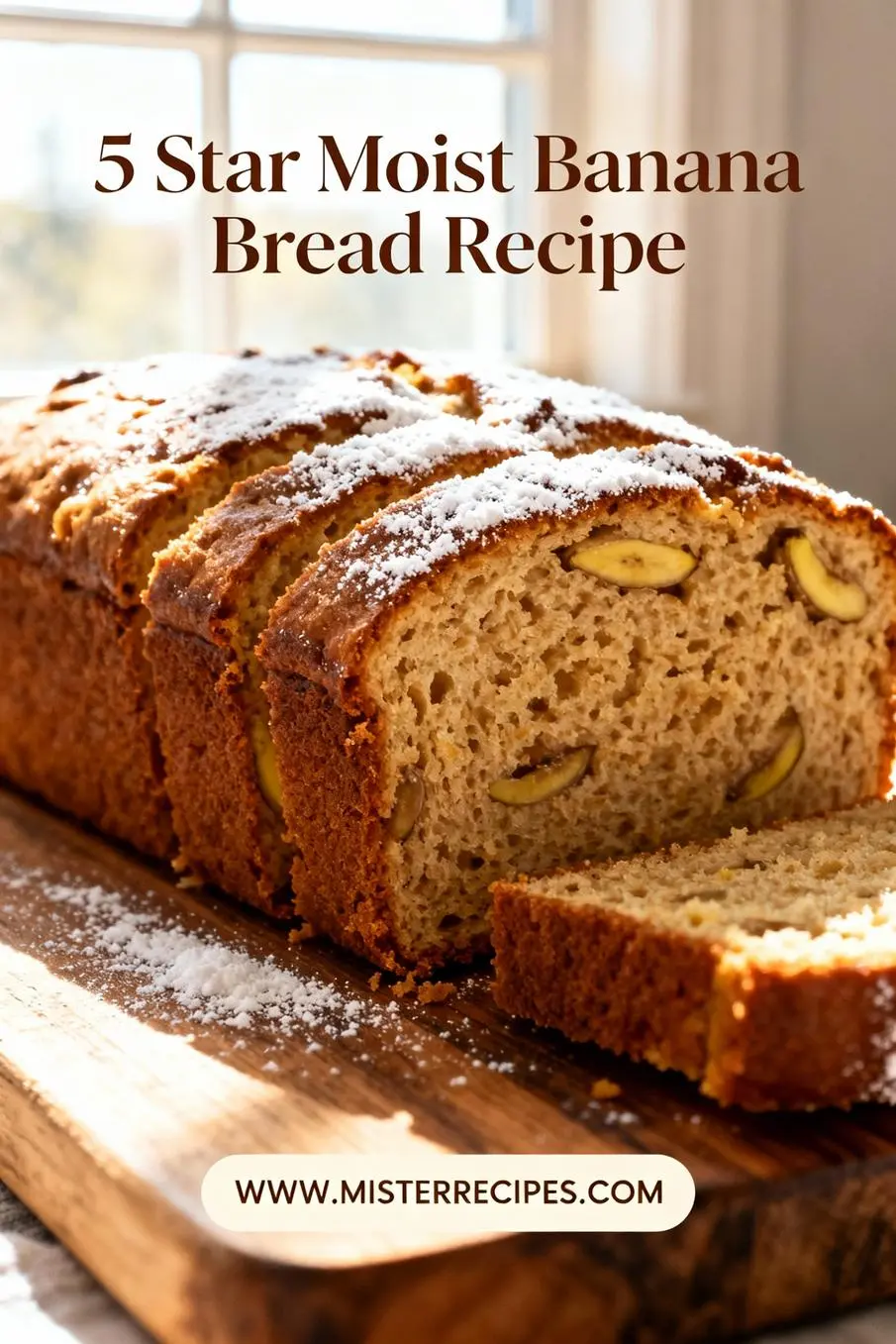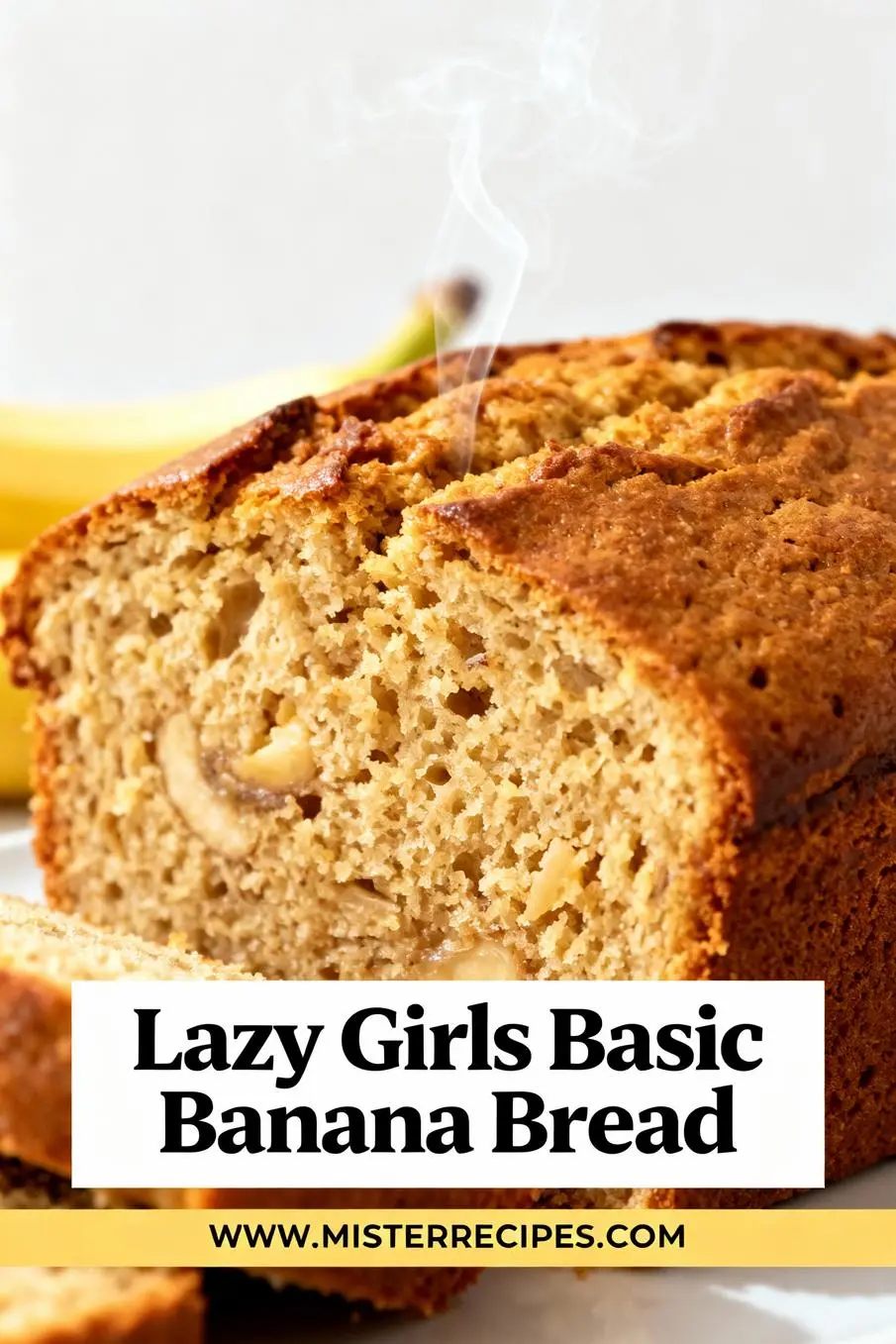Introduction
Have you noticed that side dishes often carry the meal, even more than the main event, and that people go back for seconds of the grain bowl that tastes like the season itself, not just the turkey, not just the roast. Here is a small data point the nutritionist at our community kitchen loves to remind my students of. One cooked cup of wild rice brings plant based protein, hearty fiber, and minerals like magnesium, which helps with muscle and nerve function, all inside a humble, nutty spoonful. That is the quiet magic I lean on when I make my Mushroom and Wild Rice Pilaf with Herbs. Yes, this is exactly the kind of **Mushroom Wild Rice Pilaf** that makes the table fall silent for a moment, then erupt into clinks and happy sighs.
The first time I cooked wild rice alone as a teenager in Minnesota, I over salted it and forgot the lid. My grandmother, who kept dill in a washed out pickle jar by the window, laughed and shredded parsley right into the pot. It is only rice, she said, it forgives. That little line still taps at my shoulder when I stir mushrooms in butter and olive oil, when the thyme releases its peppery perfume, when steam fogs the window and the kids trace hearts on the glass. This Mushroom and Wild Rice Pilaf with Herbs invites those small, forgiving moments. It is earthy from mushrooms, woodsy from rosemary and sage, bright with parsley and lemon, and practical enough to hold on a buffet without fuss.
I love this dish because it feeds my sentimental Midwest heart and my weekday brain. It is make ahead friendly, naturally gluten free if you choose the right stock, and wonderfully flexible. Use cremini or shiitake or the dried mushrooms hiding in the pantry. Fold in chopped kale if you need a green moment. Double it for a crowd. I make it for Sunday suppers and for holiday tables, where it sneaks in beside bronze birds and sweet glazed hams and insists, gently, that grains can be the star. If you are searching for an easy, cozy way to serve whole grains with a generous dose of umami rich flavor, this is your recipe. By the way, if you are planning your holiday lineup, here is a little something to bookmark while you read glazed ham.
Why You’ll Love This Mushroom & Wild Rice Pilaf with Herbs
Some recipes make you feel like someone has set the table for you before you even sit down. This is that kind of recipe, a friend in a skillet. Here is why I think you will love it as much as we do in our Minneapolis kitchen.
- Balanced and satisfying. Wild rice brings a toasty, nutty bite that pairs with silky sautéed mushrooms for a hearty vegetarian side or main. It tastes luxurious yet grounded, and it hits that savory sweet spot we crave in cooler months.
- Make ahead friendly. The texture actually improves as flavors mingle. You can cook the rice and the mushrooms a day ahead, then combine and warm gently before serving, making this a perfect Thanksgiving Wild Rice Pilaf or Christmas Wild Rice Pilaf option for busy days.
- Adaptable and inclusive. This can be a Vegetarian Wild Rice Pilaf as written, a dairy free version with olive oil, or a fully vegan wild rice pilaf with vegetable stock and a splash of good olive oil in place of butter. It is naturally gluten free when made with certified gluten free ingredients.
- Practical technique, big flavor. We lean on a classic flavor base, a simple mirepoix of onion, carrot, and celery, all cut small so they melt into the background. Fresh herbs, a little lemon, and a final gloss of butter give this Herbed Wild Rice Pilaf restaurant level polish without complexity.
- Season spanning comfort. Serve it alongside grilled salmon in spring, roast chicken in fall, or as part of a holiday spread in winter. It belongs everywhere, from a Tuesday night with greens to a long family table with candles and quiet laughter.
- Kid friendly, parent approved. My kids love the little pops of toasted almonds and the soft chew of wild rice. I love knowing I am serving whole grains that do not feel like homework. Add a handful of dried cranberries for a hint of sweetness if that helps your family say yes with their forks.
The best part. This recipe welcomes substitutions without judgment. If your mushrooms are a little wrinkly, they still have stories to tell. If your rice cracked open more than you expected, it is proof that you tried, and, like my grandmother used to say, rice forgives.
Ingredients for Mushroom & Wild Rice Pilaf with Herbs
– 1 and 1 half cups uncooked wild rice, rinsed well, preferably true Northern wild rice for best texture
– 4 cups low sodium vegetable stock or chicken stock for a non vegetarian version
– 2 tablespoons unsalted butter, divided, or use olive oil for dairy free
– 2 tablespoons olive oil
– 1 large yellow onion, finely chopped
– 2 ribs celery, finely chopped
– 1 medium carrot, finely chopped
– 3 garlic cloves, minced
– 1 pound mushrooms, sliced, use cremini, shiitake, or a mix, plus a handful of rehydrated dried mushrooms if you have them
– 1 teaspoon kosher salt, plus more to taste
– 1 half teaspoon freshly ground black pepper
– 1 teaspoon fresh thyme leaves, chopped
– 1 teaspoon fresh rosemary, finely chopped
– 1 teaspoon fresh sage, finely chopped
– 1 half cup flat leaf parsley, chopped, divided
– Zest of 1 lemon, plus 1 tablespoon lemon juice
– One third cup toasted sliced almonds or chopped walnuts, optional but lovely for crunch
– 2 tablespoons chopped chives, optional
– Extra olive oil or a pat of butter for finishing
Substitutions and add ins
- Use brown rice blend if needed, but increase cook time and know the texture will be softer and less nutty
- Swap in wild mushroom mix for deeper earthy flavors
- Stir in a handful of chopped kale or spinach during the final minutes for a green lift
- Use dried cranberries or currants for a gentle sweet note in holiday versions
- Use ghee if you want buttery flavor without lactose

How to Make Mushroom & Wild Rice Pilaf with Herbs
Step-by-Step Instructions
1. Rinse the wild rice until the water runs mostly clear. This removes excess starch and helps the grains cook evenly. Think of this as waking the rice up.
2. Cook the rice. In a medium pot, bring the stock to a simmer, add the rinsed wild rice, and a pinch of salt. Reduce to low, cover, and cook until the grains are tender and many have split, 45 to 55 minutes for cultivated wild rice, often 30 to 40 for true hand harvested wild rice. If the pot runs dry, add a splash of hot water. When done, drain any excess liquid, cover, and rest 5 minutes.
3. Prep the vegetables while the rice cooks. Chop onion, celery, carrot, garlic, and herbs. Slice the mushrooms with intention, not too thin, so they keep a little bite. If using dried mushrooms, soak them in hot water for 15 minutes, then chop and reserve the soaking liquid, leaving grit behind.
4. Sauté the mushrooms in batches. Heat a large skillet over medium high. Add 1 tablespoon butter and 1 tablespoon olive oil. Add half the mushrooms in a single layer. Do not stir for 2 minutes. Let contact with the hot pan draw out moisture and build golden edges. Then season with a pinch of salt and pepper, stir, and cook until browned and tender, about 5 minutes. Transfer to a bowl and repeat with remaining mushrooms. Browning in batches prevents steaming and concentrates **umami rich** notes.
5. Build the flavor base. Reduce heat to medium. Add remaining butter and olive oil to the same skillet. Stir in onion, celery, and carrot with a pinch of salt. Cook, stirring occasionally, until soft and glossy, 6 to 8 minutes. Add garlic and cook 30 seconds, just until fragrant.
6. Add the herbs. Stir in thyme, rosemary, and sage. The skillet will smell like the first step into a pine forest after rain. Cook 30 seconds to bloom the herbs in fat.
7. Combine the mushrooms and rice. Fold the browned mushrooms into the skillet. Add the cooked wild rice. Toss gently until everything is mingling and warm. If the mixture seems dry, add a splash of stock or the strained mushroom soaking liquid.
8. Brighten and season. Add lemon zest and juice, half the parsley, and half the chives if using. Taste. Add salt and pepper until it sings. The goal is balanced savoriness with a clean citrus lift.
9. Finish with texture. Fold in toasted almonds or walnuts. Turn off the heat and add a tiny drizzle of olive oil or a small pat of butter for gloss.
10. Rest and serve. Let the pilaf sit for 3 to 5 minutes, then fluff and transfer to a warm bowl. Scatter with remaining parsley and chives. If you are planning a spread, tuck this beside a crisp bird or a glazed ham. And if dessert is on your mind already, save this too Related Recipe.
Tiny reassurance. If your wild rice is a touch firmer than you expected, it will soften as it sits with the aromatic vegetables. If it is softer, let it spread out on a sheet tray for a few minutes to steam off excess moisture before you fold it into the skillet. Rice forgives. So do you.
Pro Tips & Variations
Practical tips that make a real difference
– Choose the right wild rice. True Northern wild rice, often from Minnesota tribal harvests, cooks faster and stays feather light. Cultivated wild rice takes longer and has a chewier bite. Both work. For company, I prefer the lighter texture of true wild rice so the herbs shine, making a very **Herbed Wild Rice Pilaf**.
– Dry the mushrooms. After rinsing or wiping, let mushrooms air dry on a towel for a few minutes. Dry surfaces brown better, which boosts the **umami rich** depth you want.
– Cook mushrooms in batches. Crowding traps steam. Space invites browning. Browning creates flavor. The difference between good and glowing is five quiet minutes of patience.
– Season in layers. Salt the mushroom batch lightly, season the mirepoix lightly, then adjust at the end. Layering gives you round, confident flavor without oversalting.
– Finish with lemon and parsley. The citrus and fresh herbs keep the dish from feeling heavy. You will taste more mushroom, more grain, more life.
Variations for how you cook and how you live
- Vegan variation. Use olive oil in place of butter, choose a rich vegetable broth, and finish with extra virgin olive oil. For creaminess without dairy, stir in a spoonful of tahini or a splash of oat cream. This becomes a deeply satisfying vegan wild rice pilaf for guests with plant based preferences.
- Gluten free guidance. This recipe is naturally gluten free when you use certified stock and check labels on add ins like dried cranberries. For holiday menus with multiple dietary needs, this steadies the table.
- Mushroom focused. Use a mix of cremini, shiitake, and oyster mushrooms. Add rehydrated porcini for a smoky forest note, and use the strained soaking liquid in place of some stock for extra earthy flavors.
- Holiday sparkle. Fold in dried cranberries, toasted pecans, and a small spoon of orange zest. This version fits any Thanksgiving Wild Rice Pilaf or winter feast next to crisped poultry. If you need a classic companion on the table, this is a helpful resource her.
- One pot path. If your skillet is deep and has a lid, you can simmer the wild rice directly with the sautéed vegetables after deglazing with stock. Add rice, add stock, cover, cook until tender. This saves a pot but monitor liquid closely.
- Creamy without cream. Stir in two tablespoons of cashew butter thinned with warm stock. The pilaf turns silky while staying dairy free.
- Herby switch up. Swap parsley for dill for a nod to Eastern European flavors from my grandmother, or tuck in tarragon for a delicate anise whisper.
- For a crowd. Double everything and keep warm in a low oven. To keep the grains fluffy, drizzle with a touch of stock every 30 minutes and cover loosely with foil.
- Protein add ons. Fold in shredded roast chicken, flaked salmon, or garlicky chickpeas to turn this into a full one bowl dinner. For a festive main, pair it with a showstopper, then circle back to grains for comfort. Think of this simple idea when planning her .
Troubleshooting that saves the day
- If the rice is mushy, spread on a sheet pan, let steam off for a few minutes, then fold back into the skillet over medium heat to reawaken texture.
- If flavors feel flat, add a squeeze of lemon and a pinch more salt. Brightness and seasoning are best friends.
- If mushrooms are watery, cook them a minute or two longer and do not be shy about heat. Moisture has to move out before caramelization moves in.
Serving Suggestions
We eat this pilaf warm from the skillet with soup bowls when it is just us, or pile it high in a big shallow platter for guests. Here are ways to build a plate around it that make weeknights feel like gatherings and gatherings feel easy.
- Roast and carve around it. This pilaf tucks beautifully beside crisp skinned poultry. If you want a stunning alternative main, try serving it alongside glistening citrus lacquered duck or a maple brushed bird. For crisp skinned inspiration, have a look here.
- Pair with vegetables that leap. Roasted broccolini with lemon, sizzling Brussels sprouts, or tender asparagus with a Parmesan whisper all play well with mushrooms and herbs. If you love a little char and a bright finish, bookmark this too.
- Keep it in the forest. Serve with stuffed portobello caps or a mushroom wellington for a cozy vegetarian feast that feels celebratory and deeply savory. Here is a helpful companion when mushrooms are your main character .
- Add color with a fall salad. A platter of crisp apples, bitter greens, and blue cheese turns the table into a painting and balances the warmth of the pilaf with freshness.
- Bring the holiday glow. Spoon next to a glazed ham or smoked turkey. A spoon of bright cranberry sauce on the side adds sparkle and contrast. This is one to keep handy if cranberry joy is your love language .
For smaller weeknight plates, top a warm bowl of pilaf with a jammy egg and a fistful of peppery arugula, then drizzle with olive oil. For brunch, warm it in a skillet and crown with seared halloumi or sautéed greens. For date night, serve with seared salmon and lemony green beans. The pilaf steps back while still quietly holding the center, which is exactly what good sides do.
Storage & Reheating
– Fridge. Cool completely, then store in an airtight container for up to 4 days.
– Freezer. Portion into freezer safe containers and freeze up to 2 months. Thaw in the fridge overnight before reheating.
– Reheat on the stove. Add a splash of water or stock to a skillet, then add pilaf and warm over medium low, stirring, until hot and fluffy.
– Reheat in the oven. Place pilaf in a covered baking dish, splash with stock, and warm at 325 degrees until steaming.
– Microwave. For quick lunches, add a teaspoon of water, cover loosely, and heat in short bursts, fluffing between bursts.
Texture tip. A fresh spoon of chopped parsley and a squeeze of lemon bring reheated portions back to life. A handful of toasted nuts added just before serving restores crunch.
FAQ about Mushroom & Wild Rice Pilaf with Herbs
Q. How long does it take to cook wild rice for pilaf
A. Most cultivated wild rice takes 45 to 55 minutes to turn tender with many split grains. True hand harvested Northern wild rice often cooks in 30 to 40 minutes. Start checking early and taste a few grains. The right point is tender chew, not hard in the middle, not slumped.
Q. What kind of mushrooms are best
A. Cremini are reliable and deeply savory, shiitake bring a lovely woodland perfume, and oyster add a silky chew. A mix gives the best savory rice dishes vibe. If you use dried porcini, strain their soaking liquid and add a splash to the skillet for extra umami rich depth.
Q. Can I make this ahead for the holidays
A. Yes. Cook the wild rice and sauté the mushrooms and aromatics one day ahead. Store separately. Combine in the skillet with a splash of stock before serving, then finish with herbs and lemon. This is why it is such a strong Side Dish Wild Rice Pilaf for big menus.
Q. Why did my pilaf turn mushy
A. Too much liquid or overcooking does it. Drain excess liquid after cooking, and rest the rice covered for 5 minutes to finish gently. If it is already soft, spread on a sheet pan to steam off moisture, then return to the skillet with fresh herbs for renewed texture.
Q. Is wild rice gluten free
A. Yes, wild rice is a grass and naturally gluten free. Check broth labels and any add ins to keep the whole dish friendly for gluten free eaters.
Final Thoughts on Mushroom & Wild Rice Pilaf with Herbs
Some evenings I stir this pilaf while the kids set the table with mismatched napkins and my husband Jonah tests the light by the window. The onions turn sweet, the mushrooms sigh, the herbs breathe and I can hear the small clink of a wooden spoon against cast iron. These are the minutes that teach me to trust simple food, to trust that a pot of grains and a handful of herbs can carry a whole meal and a whole mood.
If this Mushroom & Wild Rice Pilaf with Herbs finds a place at your table, I hope it brings company and calm. Pin it for later so holiday mornings feel lighter and weekday nights feel doable. Share it with the friend who needs a win in the kitchen. Leave a comment to tell me how you made it yours. Did you add dill for your grandmother. Did you tuck in cranberries for color. Did you make it your main with a big green salad. I am listening, and I am cheering you on.
If you are mapping out the rest of your menu and want one more side that snaps and sings, this caramelized green beauty is a favorite in our house crispy roasted .
May your rice be tender, your mushrooms brown, and your kitchen full of stories.

Mushroom and Wild Rice Pilaf with Herbs
Ingredients
Equipment
Method
- Rinse the wild rice until the water runs mostly clear. This removes excess starch and helps the grains cook evenly. Think of this as waking the rice up.
- Cook the rice. In a medium pot, bring the stock to a simmer, add the rinsed wild rice and a pinch of salt. Reduce heat to low, cover and cook until the grains are tender and many have split, 45 to 55 minutes for cultivated wild rice, often 30 to 40 for true hand-harvested wild rice. If the pot runs dry, add a splash of hot water. Once done, drain any excess liquid, cover, and rest for 5 minutes.
- While the rice cooks, prep the vegetables. Chop onion, celery, carrot, garlic, and herbs. Slice the mushrooms with intention, not too thin so they keep a little bite. If using dried mushrooms, soak them in hot water for 15 minutes, then chop and reserve the soaking liquid, leaving grit behind.
- Sauté the mushrooms in batches. Heat a large skillet over medium-high heat. Add 1 tablespoon butter and 1 tablespoon olive oil. Add half the mushrooms in a single layer. Do not stir for 2 minutes. Let contact with the hot pan draw out moisture and build golden edges. Then season with a pinch of salt and pepper, stir, and cook until browned and tender, about 5 minutes. Transfer to a bowl and repeat with remaining mushrooms. Browning in batches prevents steaming and concentrates umami-rich notes.
- Build the flavor base. Reduce heat to medium. Add remaining butter and olive oil to the same skillet. Stir in onion, celery, and carrot with a pinch of salt. Cook, stirring occasionally, until soft and glossy, 6 to 8 minutes. Add garlic and cook for 30 seconds, just until fragrant.
- Add the herbs. Stir in thyme, rosemary, and sage. The skillet will smell like the first step into a pine forest after rain. Cook for 30 seconds to bloom the herbs in fat.
- Combine the mushrooms and rice. Fold the browned mushrooms into the skillet. Add the cooked wild rice. Toss gently until everything is mingling and warm. If the mixture seems dry, add a splash of stock or the strained mushroom soaking liquid.
- Brighten and season. Add lemon zest and juice, half the parsley, and half the chives if using. Taste. Add salt and pepper until it sings. The goal is balanced savoriness with a clean citrus lift.
- Finish with texture. Fold in toasted almonds or walnuts. Turn off the heat and add a small drizzle of olive oil or a pats of butter for gloss.
- Let the pilaf sit for 3 to 5 minutes, then fluff and transfer to a warm bowl. Scatter with remaining parsley and chives.



